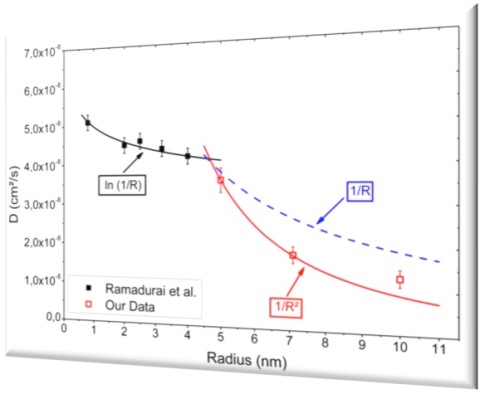https://doi.org/10.1140/epje/i2012-12118-6
Regular Article
Beyond Saffman-Delbruck approximation: A new regime for 2D diffusion of α-hemolysin complexes in supported lipid bilayer
1
CNRS, UMR7325, 13288, Aix-Marseille Université, CINaM, 13288, Marseille, France
2
Institut de Chimie et Biochimie Moléculaires et Supramoléculaires, UMR 5246 CNRS-INSA, Lyon-Université Lyon 1 - CPE Lyon, Equipe GEMBAS, Villeurbanne, France
* e-mail: tinland@cinam.univ-mrs.fr
Received:
26
April
2012
Revised:
10
September
2012
Accepted:
11
October
2012
Published online:
21
November
2012
Cell mechanisms are actively modulated by membrane dynamics. We studied the dynamics of a first-stage biomimetic system by Fluorescence Recovery After Patterned Photobleaching. Using this simple biomimetic system, constituted by  -hemolysin from Staphylococcus aureus inserted as single heptameric pore or complexes of pores in a glass-supported DMPC bilayer, we observed true diffusion behavior, with no immobile fraction. We find two situations: i) when incubation is shorter than 15 hours, the protein inserts as a heptameric pore and diffuses roughly three times more slowly than its host lipid bilayer; ii) incubation longer than 15 hours leads to the formation of larger complexes which diffuse more slowly. Our results indicate that, while the Saffman-Delbruck model adequately describes the diffusion coefficient D for small radii, D of the objects decreases as 1/R
2 for the size range explored in this study. Additionally, in the presence of inserted proteins, the gel-to-fluid transition of the supported bilayer as well as a temperature shift in the gel-to-fluid transition are observed.
-hemolysin from Staphylococcus aureus inserted as single heptameric pore or complexes of pores in a glass-supported DMPC bilayer, we observed true diffusion behavior, with no immobile fraction. We find two situations: i) when incubation is shorter than 15 hours, the protein inserts as a heptameric pore and diffuses roughly three times more slowly than its host lipid bilayer; ii) incubation longer than 15 hours leads to the formation of larger complexes which diffuse more slowly. Our results indicate that, while the Saffman-Delbruck model adequately describes the diffusion coefficient D for small radii, D of the objects decreases as 1/R
2 for the size range explored in this study. Additionally, in the presence of inserted proteins, the gel-to-fluid transition of the supported bilayer as well as a temperature shift in the gel-to-fluid transition are observed.
Key words: Living systems: Biomimetic Systems
© EDP Sciences, SIF, Springer-Verlag Berlin Heidelberg, 2012





